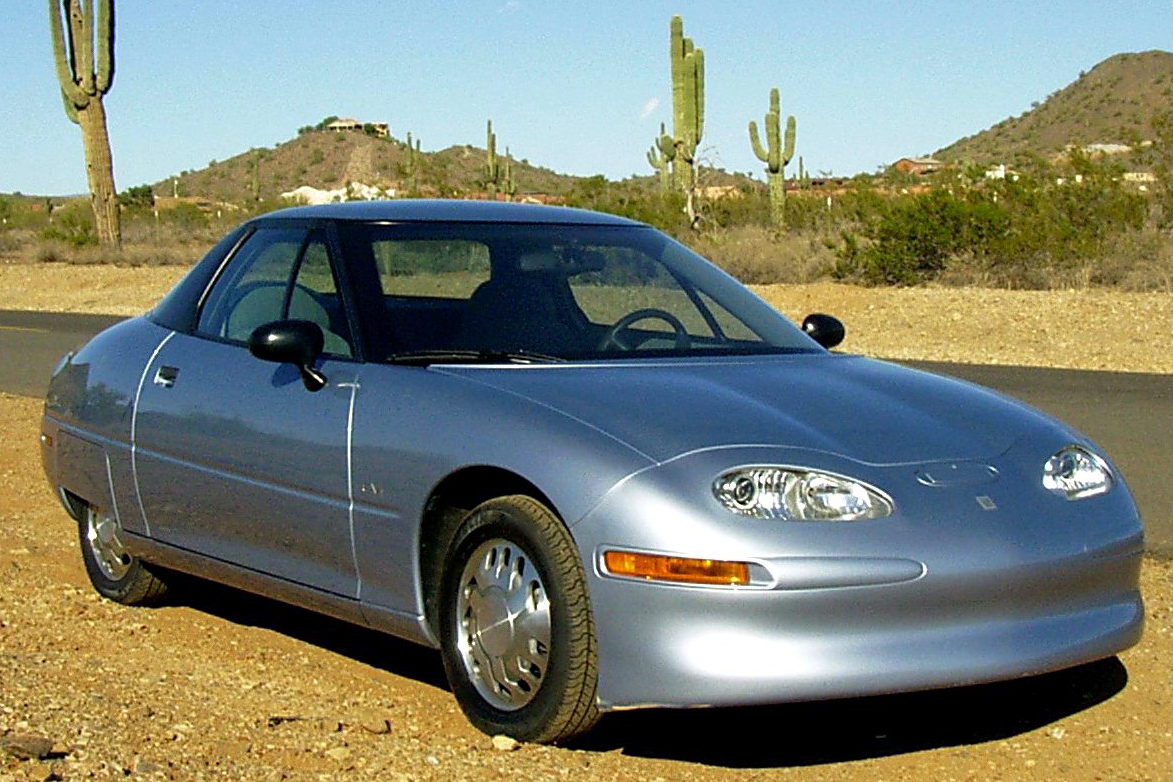
1. **Pontiac Aztek**: The Pontiac Aztek made waves with its bold and unconventional design when it was launched in 1999, receiving a mixed reception from the public. Despite its unusual appearance, this vehicle introduced a rugged design philosophy that has now become a hallmark of modern vehicles, showcasing unique angles, intriguing curves, and an innovative roofline that was groundbreaking for its time. Additionally, its split headlights with high-positioned turn signals have inspired many contemporary SUVs, like the Jeep Cherokee, demonstrating the Aztek’s lasting impact on automotive aesthetics. While it faced criticism initially, the Aztek has since garnered a passionate fan base appreciating its trailblazing spirit and distinct character.

2. **General Motors EV1**: The GM EV1 was a groundbreaking electric vehicle released in 1996, marking the first major automaker’s attempt at mass-producing an EV. While only 1,117 units were produced, the EV1 laid the foundation for the electric vehicles of today. Its initial shortcoming—limited range due to lead-acid battery technology—was the result of technology that had not yet caught up with the concept. Nonetheless, the EV1’s legacy lives on in the form of modern electric cars that have become mainstream contenders.

3. **AMC Eagle**: The AMC Eagle was truly ahead of its time, pioneering the crossover segment long before the term became mainstream in the automotive lexicon. Launched in 1980, this innovative vehicle combined a raised station wagon design with effective four-wheel drive capabilities, a concept that is now standard in many of today’s all-terrain vehicles. While its commercial journey fell short of expectations, the Eagle set a precedent by merging the comfort of passenger cars with the ruggedness of trucks, paving the way for successful crossovers like the Subaru Outback and Volvo Cross Country that we see dominating the roads today.

4. **Tucker Sedan**: The Tucker Sedan of 1948 is a testament to visionary engineering that was too advanced for its time. Equipped with features like independent suspension, an aluminum engine, and adaptive headlights, the Tucker Sedan was a marvel of innovation. Unfortunately, the market and technology of the era weren’t ready to support such advancements, resulting in only 51 cars being made. The Tucker Sedan remains a symbol of what automotive engineering could achieve with foresight and ambition.
5. **Lamborghini LM002**: Dubbed the ‘Rambo Lambo,’ the Lamborghini LM002 was an audacious venture into the realm of super SUVs when it debuted in 1986. Originally designed for military use, it boasted a powerful V12 engine and avant-garde styling that was well ahead of its time. Although it did not achieve commercial success, the LM002 laid the groundwork for the luxury performance SUVs we know today, such as the Lamborghini Urus and Aston Martin DBX, showcasing its profound influence on the evolution of high-end automotive design.

6. **Rover SD1**: The Rover SD1 of 1976 broke away from the conventional sedan designs of its time with its five-door hatchback style and V8 engine. Although it struggled with quality issues, the SD1’s innovative design is echoed in modern luxury hatchbacks and sportbacks, including offerings from Audi and Mercedes-Benz. The SD1 was a forerunner in combining premium features with practical functionality.
7. **Suzuki SX4**: Launching before subcompact crossovers became mainstream, the Suzuki SX4 offered a tall, hatchback design with raised suspension and available all-wheel drive. This configuration, introduced just before Suzuki’s exit from the North American market, closely resembles the highly popular subcompact crossovers we see today, such as the Hyundai Venue and Nissan Kicks. The SX4 was a visionary model that arrived just a bit too early.

8. **2002–2003 GMC Sierra/Chevrolet Silverado**: The 2002-2003 GMC Sierra and Chevrolet Silverado brought forth groundbreaking innovations such as the Pro-Tec bed and Quadrasteer, far surpassing the expectations of their era. The Pro-Tec composite bed was designed to reduce weight and enhance durability, while Quadrasteer provided enhanced maneuverability and stability, revolutionizing the driving experience. Although these features didn’t gain immediate popularity, their concepts have significantly influenced contemporary truck design, evident in GM’s advanced CarbonPro bed technology that prioritizes durability and performance.

These remarkable vehicles, each in their own right, challenged the norms and ushered in new possibilities for what cars could be. Their forward-thinking designs and technologies may not have been fully appreciated in their time, but they served as the building blocks for the vehicles we drive today.

Continuing our journey through automotive history, we dive into a selection of trailblazing vehicles that left significant imprints on today’s market, further unfolding the legacy of innovation that defined each of these engineering marvels.

9. **1908 Ford Model T**: When the Ford Model T rolled off the assembly line, it wasn’t just a car; it was a revolution. By pioneering the concept of the production line, Ford made cars affordable and accessible to the masses. This innovation transformed personal transportation and set a benchmark for automotive manufacturing. The Model T’s impact is still felt today, as its production methods are mirrored in countless industries worldwide.

10. **1934 Chrysler Airflow**: The Chrysler Airflow represented a bold departure into aerodynamic design, bravely challenging the norms of its time. Unfortunately, its radical styling led to lackluster sales, but the principles of aerodynamics it introduced have become cornerstones in automotive design. The legacy of the Airflow lives on, influencing the sleek and fuel-efficient vehicles we see on the roads today, establishing it as a true forerunner in modern automotive aesthetics.

11. **1934 Citroen Traction Avant**: The Citroen Traction Avant was a masterpiece of engineering, featuring front-wheel drive and a monocoque body. This innovative approach not only reduced weight but also improved crash resistance and handling, concepts that have become standard in today’s vehicles. Its advanced design was ahead of its time, influencing the development of modern automobiles across the globe.

12. **1935 Peugeot 401 Eclipse**: The Peugeot 401 Eclipse was a game changer, unveiling the concept of the retractable hardtop to the world long before it became a staple feature of luxury convertibles. This innovative design not only showcased the forward-thinking nature of Peugeot but also marked a significant milestone in the history of automotive engineering, laying the groundwork for future convertibles.

13. **1954 Mercedes Benz 300 SL**: The 1954 Mercedes Benz 300 SL captured the hearts of enthusiasts with its stunning gullwing doors and pioneering engineering, securing its place as the world’s first production supercar. Its lightweight build combined with a powerful engine set new benchmarks for performance in the automotive industry, captivating car lovers everywhere. The enduring influence of the 300 SL is reflected in the ongoing evolution and popularity of supercars, underscoring its legendary status in automotive history.

14. **1955 Citroen DS**: The Citroen DS was a marvel of technological advancement with its hydropneumatic suspension and directional headlights. Its futuristic design and groundbreaking features set new comfort and performance standards. The DS remains a symbol of innovation, inspiring modern car designs that prioritize technological integration and ride comfort.

15. **1966 Jensen Interceptor FF**: The Jensen Interceptor FF, often overlooked in automotive history, was a true pioneer in all-wheel drive technology, arriving on the scene well before Audi’s Quattro system. This remarkable vehicle introduced essential features such as anti-lock brakes, which laid the foundation for the advanced performance and safety technologies that define modern cars. Its innovative spirit continues to inspire the automotive industry today, making it a significant player in the evolution of vehicle dynamics.

16. **1966 Lamborghini Miura**: As the first supercar with a mid-engine layout, the Miura blazed a trail for high-performance vehicle design. Its groundbreaking configuration became the blueprint for modern supercars, cementing Lamborghini’s reputation as an innovator in the automotive world.

17. **1970 Range Rover**: The introduction of the 1970 Range Rover revolutionized the SUV market by skillfully merging off-road capabilities with luxurious comfort, a winning formula that remains immensely popular today. Its groundbreaking design has left a lasting imprint on the expanding luxury SUV market, inspiring numerous models that aspire to capture the same blend of ruggedness and elegance. The Range Rover’s pioneering spirit continues to thrive, showcasing the enduring appeal of this iconic vehicle in the automotive landscape.

18. **1999 Honda Insight**: While the Toyota Prius often takes the spotlight for popularizing hybrid technology, the Honda Insight quietly debuted this innovation just months earlier in 1999. Its groundbreaking ‘Integrated Motor Assist’ system and aerodynamic profile established it as a true trailblazer in fuel efficiency, signaling a shift in the automotive industry towards sustainable driving solutions. The Insight’s influence is evident in the widespread acceptance and integration of hybrid technology found in modern vehicles, solidifying its place in automotive history.
Related posts:
12 Cars and Trucks That Were Ahead of Their Time
10 Cars Ahead Of Their Time
15 Cars Which Were Way Ahead Of Their Time





